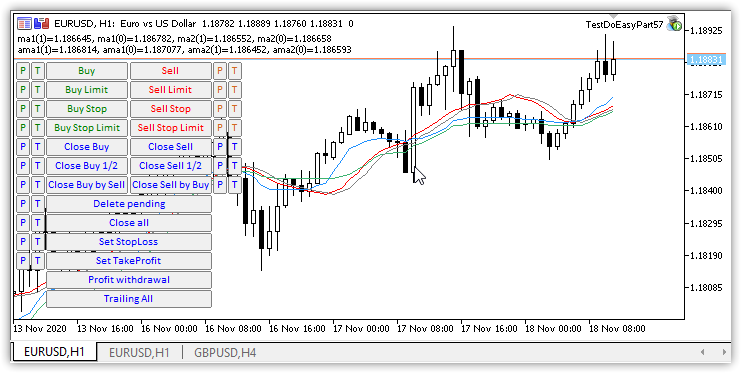内容目录
- 概述
- 改进库类
- 指标缓冲区数据对象
- 测试
- 下一步是什么?
概述
在函数库中所有数据构建和存储的概念都建立在包含一组相同类型数据的集合列表之上。 它们可按所需顺序进行选择、排序和过滤。 这样可以获取必要的数据集,从而进一步深入比较和分析。 依据它们的结构,指标缓冲区与早前创建的序列对象也没有太大不同,它们也可被包含在它们的集合列表当中,在其中我们可以快速找到包含数据的必要对象。 但是要创建一个集合,那么您必须为该集合准备至少一个数据对象。 这些数据的完整集合将存储在集合列表之中。
今天,我将创建一个数据对象,它包含一根柱线上有关指标缓冲区的所有信息,且分别包含有关缓冲区所属的指标信息,由所创建对象描述的一根柱线的数据。 />
对于一个指标单独的每个缓冲区,以及时间序列的每根柱线,将创建自己的数据对象,并按指标的品种和时间帧将其组织到所属集合列表之中。 因此,对于指标的某个副本,我将为该指标每个缓冲区时间序列的每根时间序列柱线设置一个数据集。
此刻,这种数据存储的概念似乎有点过分,因为您始终可以直接利用指标请求来获取指标缓冲区时间序列所需柱线的必要数据。 但进一步,当创建这些数据的集合时(在后续文章中),我们将能够快速找到欲创建集合的任何指标的必要数据;并执行基准分析。 对于这种状况,将数据存储在集合缓存中似乎很适当。
改进库类
首先,像往常一样,添加新的函数库消息。
在文件 \MQL5\Include\DoEasy\Data.mqh 里加入新的消息索引:
//--- CIndicatorsCollection MSG_LIB_SYS_FAILED_ADD_IND_TO_LIST, // Error. Failed to add indicator object to the list MSG_LIB_SYS_INVALID_IND_POINTER, // Error. Invalid pointer to indicator object is passed MSG_LIB_SYS_IND_ID_EXIST, // Error. Indicator object with ID already exists //--- CDataInd MSG_LIB_TEXT_IND_DATA_IND_BUFFER_NUM, // Indicator buffer number MSG_LIB_TEXT_IND_DATA_BUFFER_VALUE, // Indicator buffer value }; //+------------------------------------------------------------------+
且进一步 - 添加与新索引相对应的消息文本:
{"Error. Failed to add indicator object to list"},
{"Error. Invalid pointer to indicator object passed"},
{"Error. There is already exist an indicator object with ID"},
{"Indicator buffer number"},
{"Indicator buffer value"},
};
//+---------------------------------------------------------------------+
由于指标缓冲区数据对象会存储在集合列表当中,因此,为了对象的搜索和排序,必须接收存储在列表中的其他函数库对象的所有固有属性。
在文件 \MQL5\Include\DoEasy\Defines.mqh 里定义所有必须的对象的新属性 — 对象整数型属性:
//+------------------------------------------------------------------+ //| Data for working with indicator data | //+------------------------------------------------------------------+ //+------------------------------------------------------------------+ //| Integer properties of indicator data | //+------------------------------------------------------------------+ enum ENUM_IND_DATA_PROP_INTEGER { IND_DATA_PROP_TIME = 0, // Start time of indicator data bar period IND_DATA_PROP_PERIOD, // Indicator data period (timeframe) IND_DATA_PROP_INDICATOR_TYPE, // Indicator type IND_DATA_PROP_IND_BUFFER_NUM, // Indicator data buffer number IND_DATA_PROP_IND_ID, // Indicator ID }; #define IND_DATA_PROP_INTEGER_TOTAL (5) // Total number of indicator data integer properties #define IND_DATA_PROP_INTEGER_SKIP (0) // Number of indicator data properties not used in sorting //+------------------------------------------------------------------+
- 按时间排序是主要排序类型,其中所有数据将按其在终端中的指标缓冲区顺序进行组织。
- 时间帧值包含在整数型属性当中,如此即可在不同的时间帧上比较这两个指标缓冲区的值。
- 指标类型将包含来自 ENUM_INDICATOR 枚举的数值。
- 指标缓冲区编号 - 依据指标缓冲区的数量,从零开始的顺序编号。
- 指标 ID - 依据该指标的必要属性数据,可找到需由程序设置数值的 ID。 我们已在上一篇文章中对此进行了讨论。
对象的实数型属性:
//+------------------------------------------------------------------+ //| Indicator data real properties | //+------------------------------------------------------------------+ enum ENUM_IND_DATA_PROP_DOUBLE { //--- bar data IND_DATA_PROP_BUFFER_VALUE = IND_DATA_PROP_INTEGER_TOTAL,// Indicator data value }; #define IND_DATA_PROP_DOUBLE_TOTAL (1) // Total number of indicator data real properties #define IND_DATA_PROP_DOUBLE_SKIP (0) // Number of indicator data properties not used in sorting //+------------------------------------------------------------------+
在此,只有一个属性可用 - 指标缓冲区中的一个值,该值对应于所创建指标数据对象的柱线。
对象的字符串型属性:
//+------------------------------------------------------------------+ //| Indicator data string properties | //+------------------------------------------------------------------+ enum ENUM_IND_DATA_PROP_STRING { IND_DATA_PROP_SYMBOL = (IND_DATA_PROP_INTEGER_TOTAL+IND_DATA_PROP_DOUBLE_TOTAL), // Indicator data symbol IND_DATA_PROP_IND_NAME, // Indicator name IND_DATA_PROP_IND_SHORTNAME, // Indicator short name }; #define IND_DATA_PROP_STRING_TOTAL (3) // Total number of string properties of indicator data //+------------------------------------------------------------------+
依据这些属性值,将能够根据所计算指标的品种\指标名称和简称来选择和排序集合数据。
现在,将对象所有已创建的属性添加到可能的排序条件枚举之中:
//+------------------------------------------------------------------+ //| Possible criteria for indicator data sorting | //+------------------------------------------------------------------+ #define FIRST_IND_DATA_DBL_PROP (IND_DATA_PROP_INTEGER_TOTAL-IND_DATA_PROP_INTEGER_SKIP) #define FIRST_IND_DATA_STR_PROP (IND_DATA_PROP_INTEGER_TOTAL-IND_DATA_PROP_INTEGER_SKIP+IND_DATA_PROP_DOUBLE_TOTAL-IND_DATA_PROP_DOUBLE_SKIP) enum ENUM_SORT_IND_DATA_MODE { //--- Sort by integer properties SORT_BY_IND_DATA_TIME = 0, // Sort by bar period start time of indicator data SORT_BY_IND_DATA_PERIOD, // Sort by indicator data period (timeframe) SORT_BY_IND_DATA_INDICATOR_TYPE, // Sort by indicator type SORT_BY_IND_DATA_IND_BUFFER_NUM, // Sort by indicator data buffer number SORT_BY_IND_DATA_IND_ID, // Sort by indicator ID //--- Sort by real properties SORT_BY_IND_DATA_BUFFER_VALUE = FIRST_IND_DATA_DBL_PROP, // Sort by indicator data value //--- Sort by string properties SORT_BY_IND_DATA_SYMBOL = FIRST_IND_DATA_STR_PROP, // Sort by indicator data symbol SORT_BY_IND_DATA_IND_NAME, // Sort by indicator name SORT_BY_IND_DATA_IND_SHORTNAME, // Sort by indicator short name }; //+------------------------------------------------------------------+
指标缓冲区数据对象
对象属性已准备就绪。 现在,创建一个新对象,可存储一个指标的一个缓冲区数据。
在函数库文件夹 \MQL5\Include\DoEasy in folder \Objects\Indicators\ 里的 的 DataInd.mqh当中创建一个新类 CDataInd:
该类派生自所有函数库对象的基准对象 CBaseObj。
实际上,该对象包含了函数库对象的标准字段和方法,并且与文章第三十五部份中所分析的柱线对象相同,但与柱线对象相比,它的属性较少(对象的所有属性 - 指标缓冲区数据已在上面的枚举中进行了定义)。
我们来分析指标缓冲区数据对象的类主体:
//+------------------------------------------------------------------+ //| DataInd.mqh | //| Copyright 2020, MetaQuotes Software Corp. | //| https://mql5.com/en/users/artmedia70 | //+------------------------------------------------------------------+ #property copyright "Copyright 2020, MetaQuotes Software Corp." #property link "https://mql5.com/en/users/artmedia70" #property version "1.00" #property strict // Necessary for mql4 //+------------------------------------------------------------------+ //| Include files | //+------------------------------------------------------------------+ #include "..\BaseObj.mqh" //+------------------------------------------------------------------+ //| Indicator data class | //+------------------------------------------------------------------+ class CDataInd : public CBaseObj { private: int m_digits; // Digits value of indicator data int m_index; // Bar index string m_period_description; // Timeframe string description long m_long_prop[IND_DATA_PROP_INTEGER_TOTAL]; // Integer properties double m_double_prop[IND_DATA_PROP_DOUBLE_TOTAL]; // Real properties string m_string_prop[IND_DATA_PROP_STRING_TOTAL]; // String properties //--- Return the index of the array the object's (1) double and (2) string properties are located at int IndexProp(ENUM_IND_DATA_PROP_DOUBLE property) const { return(int)property-IND_DATA_PROP_INTEGER_TOTAL; } int IndexProp(ENUM_IND_DATA_PROP_STRING property) const { return(int)property-IND_DATA_PROP_INTEGER_TOTAL-IND_DATA_PROP_DOUBLE_TOTAL; } public: //--- Set (1) integer, (2) real and (3) string properties of indicator data void SetProperty(ENUM_IND_DATA_PROP_INTEGER property,long value) { this.m_long_prop[property]=value; } void SetProperty(ENUM_IND_DATA_PROP_DOUBLE property,double value){ this.m_double_prop[this.IndexProp(property)]=value; } void SetProperty(ENUM_IND_DATA_PROP_STRING property,string value){ this.m_string_prop[this.IndexProp(property)]=value; } //--- Return (1) integer, (2) real and (3) string property of indicator data from the properties array long GetProperty(ENUM_IND_DATA_PROP_INTEGER property) const { return this.m_long_prop[property]; } double GetProperty(ENUM_IND_DATA_PROP_DOUBLE property) const { return this.m_double_prop[this.IndexProp(property)]; } string GetProperty(ENUM_IND_DATA_PROP_STRING property) const { return this.m_string_prop[this.IndexProp(property)]; } //--- Return the flag of the object supporting this property virtual bool SupportProperty(ENUM_IND_DATA_PROP_INTEGER property) { return true; } virtual bool SupportProperty(ENUM_IND_DATA_PROP_DOUBLE property) { return true; } virtual bool SupportProperty(ENUM_IND_DATA_PROP_STRING property) { return true; } //--- Return itself CDataInd *GetObject(void) { return &this;} //--- Set (1) symbol, timeframe and time for the object, (2) indicator type, (3) number of buffers, (4) number of data buffer, //--- (5) ID, (6) data value, (7) name, (8) indicator short name void SetSymbolPeriod(const string symbol,const ENUM_TIMEFRAMES timeframe,const datetime time); void SetIndicatorType(const ENUM_INDICATOR type) { this.SetProperty(IND_DATA_PROP_INDICATOR_TYPE,type); } void SetBufferNum(const int num) { this.SetProperty(IND_DATA_PROP_IND_BUFFER_NUM,num); } void SetIndicatorID(const int id) { this.SetProperty(IND_DATA_PROP_IND_ID,id); } void SetBufferValue(const double value) { this.SetProperty(IND_DATA_PROP_BUFFER_VALUE,value); } void SetIndicatorName(const string name) { this.SetProperty(IND_DATA_PROP_IND_NAME,name); } void SetIndicatorShortname(const string shortname) { this.SetProperty(IND_DATA_PROP_IND_SHORTNAME,shortname); } //--- Compare CDataInd objects with each other by all possible properties (for sorting the lists by a specified object property) virtual int Compare(const CObject *node,const int mode=0) const; //--- Compare CDataInd objects with each other by all properties (to search equal objects) bool IsEqual(CDataInd* compared_data) const; //--- Constructors CDataInd(){;} CDataInd(const ENUM_INDICATOR ind_type, const int ind_id, const int buffer_num, const string symbol, const ENUM_TIMEFRAMES timeframe, const datetime time); //+------------------------------------------------------------------+ //| Methods of simplified access to object properties | //+------------------------------------------------------------------+ //--- Return (1) bar period start time, (2) timeframe, (3) indicator type, (4) number of buffers, (5) buffer number, (6) indicator ID datetime Time(void) const { return (datetime)this.GetProperty(IND_DATA_PROP_TIME); } ENUM_TIMEFRAMES Timeframe(void) const { return (ENUM_TIMEFRAMES)this.GetProperty(IND_DATA_PROP_PERIOD); } ENUM_INDICATOR IndicatorType(void) const { return (ENUM_INDICATOR)this.GetProperty(IND_DATA_PROP_INDICATOR_TYPE); } int BufferNum(void) const { return (ENUM_INDICATOR)this.GetProperty(IND_DATA_PROP_IND_BUFFER_NUM); } int IndicatorID(void) const { return (ENUM_INDICATOR)this.GetProperty(IND_DATA_PROP_IND_ID); } //--- Return the price of indicator buffer data double PriceValue(void) const { return this.GetProperty(IND_DATA_PROP_BUFFER_VALUE); } //--- Return (1) data symbol, (2) name, (3) indicator short name string Symbol(void) const { return this.GetProperty(IND_DATA_PROP_SYMBOL); } string IndicatorName(void) const { return this.GetProperty(IND_DATA_PROP_IND_NAME); } string IndicatorShortName(void) const { return this.GetProperty(IND_DATA_PROP_IND_SHORTNAME); } //--- Return bar index on the specified timeframe the object bar time falls into int Index(const ENUM_TIMEFRAMES timeframe) const { return ::iBarShift(this.Symbol(),(timeframe==PERIOD_CURRENT ? ::Period() : timeframe),this.Time()); } //--- Return Digits set for the object int Digits(void) const { return this.m_digits; } //+------------------------------------------------------------------+ //| Description of properties of the object - indicator data | //+------------------------------------------------------------------+ //--- Return description of object's (1) integer, (2) real and (3) string property string GetPropertyDescription(ENUM_IND_DATA_PROP_INTEGER property); string GetPropertyDescription(ENUM_IND_DATA_PROP_DOUBLE property); string GetPropertyDescription(ENUM_IND_DATA_PROP_STRING property); //--- Return indicator type description string IndicatorTypeDescription(void) const { return ::IndicatorTypeDescription(this.IndicatorType()); } //--- Display the description of object properties in the journal (full_prop=true - all properties, false - supported ones only) void Print(const bool full_prop=false); //--- Display a short description of the object in the journal virtual void PrintShort(void); //--- }; //+------------------------------------------------------------------+
我们来简要分析一下类的内容。
类的私密部分含有:
三个数组存储相应的对象属性 - 整数型、实数型和字符串型。
该方法计算对象属性在相应数组中的真实索引。
变量 - 类成员,存储其他对象属性的数值。
该类的公开部分含有:
将传递的对象属性值写入整数型、实数型和字符串型属性数组的方法。
该方法从数组里返回所请求的整数型、实数型或字符串型属性值。
虚方法返回该对象支持每个属性的标志。 这些方法应在该对象的衍生对象中实现,且如果衍生对象不支持指定的属性,则应返回 false 。 在指标缓冲区数据的对象支持所有属性,则方法返回 true。
在第一篇文章当中,我们讨论了函数库对象的整体结构。 在此,我们将简要探究其余类方法的实现。
设置和返回对象属性的所有附加方法仅在编写程序时提供更多便利;它们只是复制设置方法和接收对象属性的操作 — 因此函数库用户不必记住对象属性枚举中的常量名称,而是为正在浏览的这些属性设置和接收数值的附加方法名称。
虚拟方法 Compare() 按指定的属性比较两个对象。 它在标准库的 CObject 基准对象类中定义的,如果数值相等,则应返回零;如果所比较的数值之一或高、或低,则应分别返回 1 或 -1。 为了搜索和排序,调用标准库的 Search() 方法。 该方法应在衍生类中重新定义:
//+-------------------------------------------------------------------+ //| Compare CDataInd objects with each other by the specified property| //+-------------------------------------------------------------------+ int CDataInd::Compare(const CObject *node,const int mode=0) const { const CDataInd *obj_compared=node; //--- compare integer properties of two objects if(mode<IND_DATA_PROP_INTEGER_TOTAL) { long value_compared=obj_compared.GetProperty((ENUM_IND_DATA_PROP_INTEGER)mode); long value_current=this.GetProperty((ENUM_IND_DATA_PROP_INTEGER)mode); return(value_current>value_compared ? 1 : value_current<value_compared ? -1 : 0); } //--- compare real properties of two objects else if(mode<IND_DATA_PROP_DOUBLE_TOTAL+IND_DATA_PROP_INTEGER_TOTAL) { double value_compared=obj_compared.GetProperty((ENUM_IND_DATA_PROP_DOUBLE)mode); double value_current=this.GetProperty((ENUM_IND_DATA_PROP_DOUBLE)mode); return(value_current>value_compared ? 1 : value_current<value_compared ? -1 : 0); } //--- compare string properties of two objects else if(mode<IND_DATA_PROP_DOUBLE_TOTAL+IND_DATA_PROP_INTEGER_TOTAL+IND_DATA_PROP_STRING_TOTAL) { string value_compared=obj_compared.GetProperty((ENUM_IND_DATA_PROP_STRING)mode); string value_current=this.GetProperty((ENUM_IND_DATA_PROP_STRING)mode); return(value_current>value_compared ? 1 : value_current<value_compared ? -1 : 0); } return 0; } //+------------------------------------------------------------------+
判断指标缓冲区数据的两个相同对象的方法服务于比较两个数据对象,且仅当两个比较对象的所有字段都相等时,才返回 true:
//+------------------------------------------------------------------+ //|Compare CDataInd objects with each other by all properties | //+------------------------------------------------------------------+ bool CDataInd::IsEqual(CDataInd *compared_obj) const { int beg=0, end=BAR_PROP_INTEGER_TOTAL; for(int i=beg; i<end; i++) { ENUM_IND_DATA_PROP_INTEGER prop=(ENUM_IND_DATA_PROP_INTEGER)i; if(this.GetProperty(prop)!=compared_obj.GetProperty(prop)) return false; } beg=end; end+=IND_DATA_PROP_DOUBLE_TOTAL; for(int i=beg; i<end; i++) { ENUM_IND_DATA_PROP_DOUBLE prop=(ENUM_IND_DATA_PROP_DOUBLE)i; if(this.GetProperty(prop)!=compared_obj.GetProperty(prop)) return false; } beg=end; end+=IND_DATA_PROP_STRING_TOTAL; for(int i=beg; i<end; i++) { ENUM_IND_DATA_PROP_STRING prop=(ENUM_IND_DATA_PROP_STRING)i; if(this.GetProperty(prop)!=compared_obj.GetProperty(prop)) return false; } return true; } //+------------------------------------------------------------------+
在时间序列中设置品种、时间帧和数据对象索引的方法:
//+------------------------------------------------------------------+ //| Set symbol, timeframe and object bar start time | //+------------------------------------------------------------------+ void CDataInd::SetSymbolPeriod(const string symbol,const ENUM_TIMEFRAMES timeframe,const datetime time) { this.SetProperty(IND_DATA_PROP_TIME,time); this.SetProperty(IND_DATA_PROP_SYMBOL,symbol); this.SetProperty(IND_DATA_PROP_PERIOD,timeframe); } //+------------------------------------------------------------------+
在日志里显示所有对象属性说明的方法:
//+------------------------------------------------------------------+ //| Display object properties in the journal | //+------------------------------------------------------------------+ void CDataInd::Print(const bool full_prop=false) { ::Print("============= ",CMessage::Text(MSG_LIB_PARAMS_LIST_BEG)," (",this.IndicatorShortName(),") ============="); int beg=0, end=IND_DATA_PROP_INTEGER_TOTAL; for(int i=beg; i<end; i++) { ENUM_IND_DATA_PROP_INTEGER prop=(ENUM_IND_DATA_PROP_INTEGER)i; if(!full_prop && !this.SupportProperty(prop)) continue; ::Print(this.GetPropertyDescription(prop)); } ::Print("------"); beg=end; end+=IND_DATA_PROP_DOUBLE_TOTAL; for(int i=beg; i<end; i++) { ENUM_IND_DATA_PROP_DOUBLE prop=(ENUM_IND_DATA_PROP_DOUBLE)i; if(!full_prop && !this.SupportProperty(prop)) continue; ::Print(this.GetPropertyDescription(prop)); } ::Print("------"); beg=end; end+=IND_DATA_PROP_STRING_TOTAL; for(int i=beg; i<end; i++) { ENUM_IND_DATA_PROP_STRING prop=(ENUM_IND_DATA_PROP_STRING)i; if(!full_prop && !this.SupportProperty(prop)) continue; ::Print(this.GetPropertyDescription(prop)); } ::Print("============= ",CMessage::Text(MSG_LIB_PARAMS_LIST_END)," (",this.IndicatorShortName(),") =============\n"); } //+------------------------------------------------------------------+
在三个循环中显示对象属性数组每个属性的描述。 如果不支持该属性,它不会在日志里显示 full_prop 方法的输入参数是否为 false (默认)。
在日志中显示简短对象描述的虚拟方法:
//+------------------------------------------------------------------+ //| Display a short description of the object in the journal | //+------------------------------------------------------------------+ void CDataInd::PrintShort(void) { ::Print ( this.IndicatorShortName(), " [",CMessage::Text(MSG_LIB_TEXT_BUFFER_TEXT_BUFFER)," ",this.BufferNum(), ", ",CMessage::Text(MSG_SYM_STATUS_INDEX)," ",this.Index(this.Timeframe()),"]" ); } //+------------------------------------------------------------------+
该方法遵照以下格式显示标准指标缓冲区数据的描述:
AMA(EURUSD,H1) [Buffer 0, Index 0]
对于自定义指标:
Examples\Custom Moving Average.ex5(EURUSD,H1) [Buffer 0, Index 1]
可利用 SetIndicatorShortname() 方法更改已包含在缓冲区数据描述中的指标简称。 该方法可在衍生对象中更改,以便显示在衍生对象中实现的相对应数据对象的其他描述。
返回对象的整数型、实数型和字符串型属性描述的方法:
//+------------------------------------------------------------------+ //| Return description of object's integer property | //+------------------------------------------------------------------+ string CDataInd::GetPropertyDescription(ENUM_IND_DATA_PROP_INTEGER property) { return ( property==IND_DATA_PROP_TIME ? CMessage::Text(MSG_LIB_TEXT_BAR_TIME)+ (!this.SupportProperty(property) ? ": "+CMessage::Text(MSG_LIB_PROP_NOT_SUPPORTED) : ": "+::TimeToString(this.GetProperty(property),TIME_DATE|TIME_MINUTES|TIME_SECONDS) ) : property==IND_DATA_PROP_PERIOD ? CMessage::Text(MSG_LIB_TEXT_IND_TEXT_TIMEFRAME)+ (!this.SupportProperty(property) ? ": "+CMessage::Text(MSG_LIB_PROP_NOT_SUPPORTED) : ": "+this.m_period_description ) : property==IND_DATA_PROP_INDICATOR_TYPE ? CMessage::Text(MSG_LIB_TEXT_IND_TEXT_TYPE)+ (!this.SupportProperty(property) ? ": "+CMessage::Text(MSG_LIB_PROP_NOT_SUPPORTED) : ": "+this.IndicatorTypeDescription() ) : property==IND_DATA_PROP_IND_BUFFER_NUM ? CMessage::Text(MSG_LIB_TEXT_IND_DATA_IND_BUFFER_NUM)+ (!this.SupportProperty(property) ? ": "+CMessage::Text(MSG_LIB_PROP_NOT_SUPPORTED) : ": "+(string)this.GetProperty(property) ) : property==IND_DATA_PROP_IND_ID ? CMessage::Text(MSG_LIB_TEXT_IND_TEXT_ID)+ (!this.SupportProperty(property) ? ": "+CMessage::Text(MSG_LIB_PROP_NOT_SUPPORTED) : ": "+(string)this.GetProperty(property) ) : "" ); } //+------------------------------------------------------------------+ //| Return description of object's real property | //+------------------------------------------------------------------+ string CDataInd::GetPropertyDescription(ENUM_IND_DATA_PROP_DOUBLE property) { int dg=(this.m_digits>0 ? this.m_digits : 1); return ( property==IND_DATA_PROP_BUFFER_VALUE ? CMessage::Text(MSG_LIB_TEXT_IND_DATA_BUFFER_VALUE)+ (!this.SupportProperty(property) ? ": "+CMessage::Text(MSG_LIB_PROP_NOT_SUPPORTED) : ": "+::DoubleToString(this.GetProperty(property),dg) ) : "" ); } //+------------------------------------------------------------------+ //| Return description of object's string property | //+------------------------------------------------------------------+ string CDataInd::GetPropertyDescription(ENUM_IND_DATA_PROP_STRING property) { return ( property==IND_DATA_PROP_SYMBOL ? CMessage::Text(MSG_LIB_TEXT_IND_TEXT_SYMBOL)+": \""+this.GetProperty(property)+"\"" : property==IND_DATA_PROP_IND_NAME ? CMessage::Text(MSG_LIB_TEXT_IND_TEXT_NAME)+": \""+this.GetProperty(property)+"\"" : property==IND_DATA_PROP_IND_SHORTNAME ? CMessage::Text(MSG_LIB_TEXT_IND_TEXT_SHORTNAME)+": \""+this.GetProperty(property)+"\"" : "" ); } //+------------------------------------------------------------------+
这些方法接收相应的属性,并根据其值返回已添加到上述 Datas.mqh 文件中设置的文本说明。
该类含有两个构造函数。
默认情况下,第一个构造函数会创建一个空的数据对象,然后必须用所有必要的数据填充该对象。
第二个是参数化构造函数;它为了创建含有指定基本属性的对象,接收必要的数据:
//+------------------------------------------------------------------+ //| Constructor | //+------------------------------------------------------------------+ CDataInd::CDataInd(const ENUM_INDICATOR ind_type, const int ind_id, const int buffer_num, const string symbol, const ENUM_TIMEFRAMES timeframe, const datetime time) { this.m_type=COLLECTION_INDICATORS_ID; this.m_digits=(int)::SymbolInfoInteger(symbol,SYMBOL_DIGITS)+1; this.m_period_description=TimeframeDescription(timeframe); this.SetSymbolPeriod(symbol,timeframe,time); this.SetIndicatorType(ind_type); this.SetBufferNum(buffer_num); this.SetIndicatorID(ind_id); } //+------------------------------------------------------------------+
一次性为对象指定:指标类型,其为该对象定义的缓冲区数据,指标 ID - ,我们可以在所有已创建的指标对象中依据此属性快速搜索,得到早前创建的指标对象的缓冲区数据。 由对象定义的指标缓冲区编号,创建指标对象时依据的品种和时间帧,以及由创建对象定义的缓冲区数据开始时间。
除了添加上述指定的参数外,构造函数还设置了显示指标缓冲区数值的默认小数位数(品种的小数位数 + 1 位数字),并将时间帧的描述添加到变量 m_period_description — 当创建对象时也许已设置过一次说明。 对于变量 m_type,其已在标准库的 CObject 父类里定义过了,那时写入了一个临时指标集合 ID。 此外,在创建指标缓冲区数据集合时,我会将这个新集合的 ID 添加到该变量之中。
现在,为了能够对数据集合中的数据对象进行排序(我将从下一篇文章开始制作数据集合),将按其属性排序新对象的操作方法添加到文件 \MQL5\Include\DoEasy\Services\Select.mqh。
将刚刚创建的指标缓冲区数据对象类包含到文件中:
//+------------------------------------------------------------------+ //| Select.mqh | //| Copyright 2020, MetaQuotes Software Corp. | //| https://mql5.com/en/users/artmedia70 | //+------------------------------------------------------------------+ #property copyright "Copyright 2020, MetaQuotes Software Corp." #property link "https://mql5.com/en/users/artmedia70" #property version "1.00" //+------------------------------------------------------------------+ //| Include files | //+------------------------------------------------------------------+ #include <Arrays\ArrayObj.mqh> #include "..\Objects\Orders\Order.mqh" #include "..\Objects\Events\Event.mqh" #include "..\Objects\Accounts\Account.mqh" #include "..\Objects\Symbols\Symbol.mqh" #include "..\Objects\PendRequest\PendRequest.mqh" #include "..\Objects\Series\SeriesDE.mqh" #include "..\Objects\Indicators\Buffer.mqh" #include "..\Objects\Indicators\IndicatorDE.mqh" #include "..\Objects\Indicators\DataInd.mqh" //+------------------------------------------------------------------+
在类主体的最后,声明操作刚创建的指标数据对象类的方法:
//+------------------------------------------------------------------+ //| Methods of work with indicator data | //+------------------------------------------------------------------+ //--- Return the list of indicator data with one out of (1) integer, (2) real and (3) string properties meeting a specified criterion static CArrayObj *ByIndicatorDataProperty(CArrayObj *list_source,ENUM_IND_DATA_PROP_INTEGER property,long value,ENUM_COMPARER_TYPE mode); static CArrayObj *ByIndicatorDataProperty(CArrayObj *list_source,ENUM_IND_DATA_PROP_DOUBLE property,double value,ENUM_COMPARER_TYPE mode); static CArrayObj *ByIndicatorDataProperty(CArrayObj *list_source,ENUM_IND_DATA_PROP_STRING property,string value,ENUM_COMPARER_TYPE mode); //--- Return the indicator data index in the list with the maximum value of (1) integer, (2) real and (3) string property of data static int FindIndDataMax(CArrayObj *list_source,ENUM_IND_DATA_PROP_INTEGER property); static int FindIndDataMax(CArrayObj *list_source,ENUM_IND_DATA_PROP_DOUBLE property); static int FindIndDataMax(CArrayObj *list_source,ENUM_IND_DATA_PROP_STRING property); //--- Return the indicator data index in the list with the minimum value of (1) integer, (2) real and (3) string property of data static int FindIndDataMin(CArrayObj *list_source,ENUM_IND_DATA_PROP_INTEGER property); static int FindIndDataMin(CArrayObj *list_source,ENUM_IND_DATA_PROP_DOUBLE property); static int FindIndDataMin(CArrayObj *list_source,ENUM_IND_DATA_PROP_STRING property); //--- }; //+------------------------------------------------------------------+
在文件末尾实现所有声明的方法:
//+------------------------------------------------------------------+ //+------------------------------------------------------------------+ //| Methods of work with indicator data lists | //+------------------------------------------------------------------+ //+------------------------------------------------------------------+ //| Return the list of indicators data with one of integer | //| properties meeting the specified criterion | //+------------------------------------------------------------------+ CArrayObj *CSelect::ByIndicatorDataProperty(CArrayObj *list_source,ENUM_IND_DATA_PROP_INTEGER property,long value,ENUM_COMPARER_TYPE mode) { if(list_source==NULL) return NULL; CArrayObj *list=new CArrayObj(); if(list==NULL) return NULL; list.FreeMode(false); ListStorage.Add(list); int total=list_source.Total(); for(int i=0; i<total; i++) { CDataInd *obj=list_source.At(i); if(!obj.SupportProperty(property)) continue; long obj_prop=obj.GetProperty(property); if(CompareValues(obj_prop,value,mode)) list.Add(obj); } return list; } //+------------------------------------------------------------------+ //| Return the list of indicators data with one of real | //| properties meeting the specified criterion | //+------------------------------------------------------------------+ CArrayObj *CSelect::ByIndicatorDataProperty(CArrayObj *list_source,ENUM_IND_DATA_PROP_DOUBLE property,double value,ENUM_COMPARER_TYPE mode) { if(list_source==NULL) return NULL; CArrayObj *list=new CArrayObj(); if(list==NULL) return NULL; list.FreeMode(false); ListStorage.Add(list); for(int i=0; i<list_source.Total(); i++) { CDataInd *obj=list_source.At(i); if(!obj.SupportProperty(property)) continue; double obj_prop=obj.GetProperty(property); if(CompareValues(obj_prop,value,mode)) list.Add(obj); } return list; } //+------------------------------------------------------------------+ //| Return the list of indicators data with one of string | //| properties meeting the specified criterion | //+------------------------------------------------------------------+ CArrayObj *CSelect::ByIndicatorDataProperty(CArrayObj *list_source,ENUM_IND_DATA_PROP_STRING property,string value,ENUM_COMPARER_TYPE mode) { if(list_source==NULL) return NULL; CArrayObj *list=new CArrayObj(); if(list==NULL) return NULL; list.FreeMode(false); ListStorage.Add(list); for(int i=0; i<list_source.Total(); i++) { CDataInd *obj=list_source.At(i); if(!obj.SupportProperty(property)) continue; string obj_prop=obj.GetProperty(property); if(CompareValues(obj_prop,value,mode)) list.Add(obj); } return list; } //+------------------------------------------------------------------+ //| Return the indicator data index in the list | //| with the maximum integer property value | //+------------------------------------------------------------------+ int CSelect::FindIndDataMax(CArrayObj *list_source,ENUM_IND_DATA_PROP_INTEGER property) { if(list_source==NULL) return WRONG_VALUE; int index=0; CDataInd *max_obj=NULL; int total=list_source.Total(); if(total==0) return WRONG_VALUE; for(int i=1; i<total; i++) { CDataInd *obj=list_source.At(i); long obj1_prop=obj.GetProperty(property); max_obj=list_source.At(index); long obj2_prop=max_obj.GetProperty(property); if(CompareValues(obj1_prop,obj2_prop,MORE)) index=i; } return index; } //+------------------------------------------------------------------+ //| Return the indicator data index in the list | //| with the maximum real property value | //+------------------------------------------------------------------+ int CSelect::FindIndDataMax(CArrayObj *list_source,ENUM_IND_DATA_PROP_DOUBLE property) { if(list_source==NULL) return WRONG_VALUE; int index=0; CDataInd *max_obj=NULL; int total=list_source.Total(); if(total==0) return WRONG_VALUE; for(int i=1; i<total; i++) { CDataInd *obj=list_source.At(i); double obj1_prop=obj.GetProperty(property); max_obj=list_source.At(index); double obj2_prop=max_obj.GetProperty(property); if(CompareValues(obj1_prop,obj2_prop,MORE)) index=i; } return index; } //+------------------------------------------------------------------+ //| Return the indicator data index in the list | //| with the maximum string property value | //+------------------------------------------------------------------+ int CSelect::FindIndDataMax(CArrayObj *list_source,ENUM_IND_DATA_PROP_STRING property) { if(list_source==NULL) return WRONG_VALUE; int index=0; CDataInd *max_obj=NULL; int total=list_source.Total(); if(total==0) return WRONG_VALUE; for(int i=1; i<total; i++) { CDataInd *obj=list_source.At(i); string obj1_prop=obj.GetProperty(property); max_obj=list_source.At(index); string obj2_prop=max_obj.GetProperty(property); if(CompareValues(obj1_prop,obj2_prop,MORE)) index=i; } return index; } //+------------------------------------------------------------------+ //| Return the indicator data index in the list | //| with the minimum integer property value | //+------------------------------------------------------------------+ int CSelect::FindIndDataMin(CArrayObj* list_source,ENUM_IND_DATA_PROP_INTEGER property) { int index=0; CDataInd *min_obj=NULL; int total=list_source.Total(); if(total==0) return WRONG_VALUE; for(int i=1; i<total; i++) { CDataInd *obj=list_source.At(i); long obj1_prop=obj.GetProperty(property); min_obj=list_source.At(index); long obj2_prop=min_obj.GetProperty(property); if(CompareValues(obj1_prop,obj2_prop,LESS)) index=i; } return index; } //+------------------------------------------------------------------+ //| Return the indicator data index in the list | //| with the minimum real property value | //+------------------------------------------------------------------+ int CSelect::FindIndDataMin(CArrayObj* list_source,ENUM_IND_DATA_PROP_DOUBLE property) { int index=0; CDataInd *min_obj=NULL; int total=list_source.Total(); if(total== 0) return WRONG_VALUE; for(int i=1; i<total; i++) { CDataInd *obj=list_source.At(i); double obj1_prop=obj.GetProperty(property); min_obj=list_source.At(index); double obj2_prop=min_obj.GetProperty(property); if(CompareValues(obj1_prop,obj2_prop,LESS)) index=i; } return index; } //+------------------------------------------------------------------+ //| Return the indicator data index in the list | //| with the minimum string property value | //+------------------------------------------------------------------+ int CSelect::FindIndDataMin(CArrayObj* list_source,ENUM_IND_DATA_PROP_STRING property) { int index=0; CDataInd *min_obj=NULL; int total=list_source.Total(); if(total==0) return WRONG_VALUE; for(int i=1; i<total; i++) { CDataInd *obj=list_source.At(i); string obj1_prop=obj.GetProperty(property); min_obj=list_source.At(index); string obj2_prop=min_obj.GetProperty(property); if(CompareValues(obj1_prop,obj2_prop,LESS)) index=i; } return index; } //+------------------------------------------------------------------+
在函数库创建讲述的第三篇文章中详细分析了这些方法的功能。
故此,新的指标缓冲区数据对象已创建,且现在就可以对其进行测试了。
测试
为了执行测试,我们取用来自上一篇文章中的 EA ,并将其保存在新文件夹中
\MQL5\Experts\TestDoEasy\Part57\,命名为新名称 TestDoEasyPart57.mq5。
在上一个 EA 中,我创建了四个指标对象:两个标准对象和两个自定义对象。 相同的指标仅在其参数上彼此不同。 在此,创建相同的四个指标,但为了显示它们的数据,需为它们的每一个创建两个缓冲区数据对象 - 针对时间序列的当前(零)和前一根(第一根)柱线。 所有对象的数据均会被显示在品种图表上的注释里。
在创建指标缓冲区数据集合之前,我们规划 EA 直接访问已创建的类。
为此,将该类包含到 EA 文件:
//+------------------------------------------------------------------+ //| TestDoEasyPart57.mq5 | //| Copyright 2020, MetaQuotes Software Corp. | //| https://mql5.com/en/users/artmedia70 | //+------------------------------------------------------------------+ #property copyright "Copyright 2020, MetaQuotes Software Corp." #property link "https://mql5.com/en/users/artmedia70" #property version "1.00" //--- includes #include <DoEasy\Engine.mqh> #include <DoEasy\Objects\Indicators\DataInd.mqh> //--- enums
In the same place, in the area of global variables of the program add variable pointers to indicator data objects:
//--- Arrays of custom indicator parameters MqlParam param_ma1[]; MqlParam param_ma2[]; //--- Pointers to indicator data objects CDataInd *data_ma1_0=NULL; CDataInd *data_ma1_1=NULL; CDataInd *data_ma2_0=NULL; CDataInd *data_ma2_1=NULL; CDataInd *data_ama1_0=NULL; CDataInd *data_ama1_1=NULL; CDataInd *data_ama2_0=NULL; CDataInd *data_ama2_1=NULL; //+------------------------------------------------------------------+
当创建新的数据对象时,我会将指向新创建对象的指针保存到这些变量之中,从而以后可以访问它们。
由于将使用操作符 new 创建所有对象,因此使用完毕之后必须单独将它们全部删除。 我将在 EA 的 OnDeinit() 处理程序中执行此操作(在创建指标缓冲区数据集合之后,在 EA 中无需执行这些操作):
//+------------------------------------------------------------------+ //| Expert deinitialization function | //+------------------------------------------------------------------+ void OnDeinit(const int reason) { //--- Remove EA graphical objects by an object name prefix ObjectsDeleteAll(0,prefix); Comment(""); //--- Remove created data objects of MA indicators if(CheckPointer(data_ma1_0)==POINTER_DYNAMIC) delete data_ma1_0; if(CheckPointer(data_ma1_1)==POINTER_DYNAMIC) delete data_ma1_1; if(CheckPointer(data_ma2_0)==POINTER_DYNAMIC) delete data_ma2_0; if(CheckPointer(data_ma2_1)==POINTER_DYNAMIC) delete data_ma2_1; //--- Remove created data objects of AMA indicators if(CheckPointer(data_ama1_0)==POINTER_DYNAMIC) delete data_ama1_0; if(CheckPointer(data_ama1_1)==POINTER_DYNAMIC) delete data_ama1_1; if(CheckPointer(data_ama2_0)==POINTER_DYNAMIC) delete data_ama2_0; if(CheckPointer(data_ama2_1)==POINTER_DYNAMIC) delete data_ama2_1; //--- Deinitialize library engine.OnDeinit(); } //+------------------------------------------------------------------+
在 OnTick() 处理程序中,创建新对象(除非已创建),为它们填充所有必要的数据和数值,并在日志中显示对象的描述;同时,在图表上显示由对象定义的指标缓冲区数值:
//+------------------------------------------------------------------+ //| Expert tick function | //+------------------------------------------------------------------+ void OnTick() { //--- Handle the NewTick event in the library engine.OnTick(rates_data); //--- If work in tester if(MQLInfoInteger(MQL_TESTER)) { engine.OnTimer(rates_data); // Work in timer PressButtonsControl(); // Button press control engine.EventsHandling(); // Work with events } //--- Get custom indicator objects CIndicatorDE *ma1=engine.GetIndicatorsCollection().GetIndByID(MA1); CIndicatorDE *ma2=engine.GetIndicatorsCollection().GetIndByID(MA2); CIndicatorDE *ama1=engine.GetIndicatorsCollection().GetIndByID(AMA1); CIndicatorDE *ama2=engine.GetIndicatorsCollection().GetIndByID(AMA2); //--- Write bar start time 0 and 1 to specify it in properties of further created objects datetime time0=iTime(ma1.Symbol(),ma1.Timeframe(),0); datetime time1=iTime(ma1.Symbol(),ma1.Timeframe(),1); if(time0==0 || time1==0) return; //--- Create data objects of МА1 and МА2 for bars 0 and 1 (unless the objects are created) if(data_ma1_0==NULL) data_ma1_0=new CDataInd(ma1.TypeIndicator(),ma1.ID(),0,ma1.Symbol(),ma1.Timeframe(),time0); if(data_ma1_1==NULL) data_ma1_1=new CDataInd(ma1.TypeIndicator(),ma1.ID(),0,ma1.Symbol(),ma1.Timeframe(),time1); if(data_ma2_0==NULL) data_ma2_0=new CDataInd(ma2.TypeIndicator(),ma2.ID(),0,ma2.Symbol(),ma2.Timeframe(),time0); if(data_ma2_1==NULL) data_ma2_1=new CDataInd(ma2.TypeIndicator(),ma2.ID(),0,ma2.Symbol(),ma2.Timeframe(),time1); if(data_ma1_0==NULL || data_ma1_1==NULL || data_ma2_0==NULL || data_ma2_1==NULL) return; //--- Set parameters of data object of indicator МА1, bar 0 //--- and add indicator buffer data to the object data_ma1_0.SetIndicatorType(ma1.TypeIndicator()); data_ma1_0.SetIndicatorName(ma1.Name()); data_ma1_0.SetIndicatorShortname(ma1.ShortName()); data_ma1_0.SetBufferValue(ma1.GetDataBuffer(0,time0)); //--- Set parameters of data object of indicator МА1, bar 1 //--- and add indicator buffer data to the object data_ma1_1.SetIndicatorType(ma1.TypeIndicator()); data_ma1_1.SetIndicatorName(ma1.Name()); data_ma1_1.SetIndicatorShortname(ma1.ShortName()); data_ma1_1.SetBufferValue(ma1.GetDataBuffer(0,time1)); //--- Set parameters of data object of indicator МА2, bar 0 //--- and add indicator buffer data to the object data_ma2_0.SetIndicatorType(ma2.TypeIndicator()); data_ma2_0.SetIndicatorName(ma2.Name()); data_ma2_0.SetIndicatorShortname(ma2.ShortName()); data_ma2_0.SetBufferValue(ma2.GetDataBuffer(0,time0)); //--- Set parameters of data object of indicator МА2, bar 1 //--- and add indicator buffer data to the object data_ma2_1.SetIndicatorType(ma2.TypeIndicator()); data_ma2_1.SetIndicatorName(ma2.Name()); data_ma2_1.SetIndicatorShortname(ma2.ShortName()); data_ma2_1.SetBufferValue(ma2.GetDataBuffer(0,time1)); //--- Create data objects of АМА1 and АМА2 for bars 0 and 1 (unless the objects are already created) if(data_ama1_0==NULL) data_ama1_0=new CDataInd(ama1.TypeIndicator(),ama1.ID(),0,ama1.Symbol(),ama1.Timeframe(),time0); if(data_ama1_1==NULL) data_ama1_1=new CDataInd(ama1.TypeIndicator(),ama1.ID(),0,ama1.Symbol(),ama1.Timeframe(),time1); if(data_ama2_0==NULL) data_ama2_0=new CDataInd(ama2.TypeIndicator(),ama2.ID(),0,ama2.Symbol(),ama2.Timeframe(),time0); if(data_ama2_1==NULL) data_ama2_1=new CDataInd(ama2.TypeIndicator(),ama2.ID(),0,ama2.Symbol(),ama2.Timeframe(),time1); if(data_ama1_0==NULL || data_ama1_1==NULL || data_ama2_0==NULL || data_ama2_1==NULL) return; //--- Set parameters of data object of indicator АМА1, bar 0 //--- and add indicator buffer data to the object data_ama1_0.SetIndicatorType(ama1.TypeIndicator()); data_ama1_0.SetIndicatorName(ama1.Name()); data_ama1_0.SetIndicatorShortname(ama1.ShortName()); data_ama1_0.SetBufferValue(ama1.GetDataBuffer(0,time0)); //--- Set parameters of data object of indicator АМА1, bar 1 //--- and add indicator buffer data to the object data_ama1_1.SetIndicatorType(ama1.TypeIndicator()); data_ama1_1.SetIndicatorName(ama1.Name()); data_ama1_1.SetIndicatorShortname(ama1.ShortName()); data_ama1_1.SetBufferValue(ama1.GetDataBuffer(0,time1)); //--- Set parameters of data object of indicator АМА2, bar 0 //--- and add indicator buffer data to the object data_ama2_0.SetIndicatorType(ama2.TypeIndicator()); data_ama2_0.SetIndicatorName(ama2.Name()); data_ama2_0.SetIndicatorShortname(ama2.ShortName()); data_ama2_0.SetBufferValue(ama2.GetDataBuffer(0,time0)); //--- Set parameters of data object of indicator АМА2, bar 1 //--- and add indicator buffer data to the object data_ama2_1.SetIndicatorType(ama2.TypeIndicator()); data_ama2_1.SetIndicatorName(ama2.Name()); data_ama2_1.SetIndicatorShortname(ama2.ShortName()); data_ama2_1.SetBufferValue(ama2.GetDataBuffer(0,time1)); //--- During the first launch, print full and short data of created indicator data objects static bool first_start=true; if(first_start) { //--- Full data of buffers МА1 and МА2 data_ma1_0.Print(); data_ma1_1.Print(); data_ma2_0.Print(); data_ma2_1.Print(); //--- Full data of buffers АМА1 and АМА2 data_ama1_0.Print(); data_ama1_1.Print(); data_ama2_0.Print(); data_ama2_1.Print(); //--- Short data of buffers МА1 and МА2 data_ma1_0.PrintShort(); data_ma1_1.PrintShort(); data_ma2_0.PrintShort(); data_ma2_1.PrintShort(); //--- Short data of buffers АМА1 and АМА2 data_ama1_0.PrintShort(); data_ama1_1.PrintShort(); data_ama2_0.PrintShort(); data_ama2_1.PrintShort(); //--- first_start=false; } //--- Display the values of indicator buffers to comment on the chart from data objects Comment ( "ma1(1)=",DoubleToString(data_ma1_1.PriceValue(),6),", ma1(0)=",DoubleToString(data_ma1_0.PriceValue(),data_ma1_0.Digits()),", ", "ma2(1)=",DoubleToString(data_ma2_1.PriceValue(),6),", ma2(0)=",DoubleToString(data_ma2_0.PriceValue(),data_ma2_0.Digits()),"\n", "ama1(1)=",DoubleToString(data_ama1_1.PriceValue(),6),", ama1(0)=",DoubleToString(data_ama1_0.PriceValue(),data_ama1_0.Digits()),", ", "ama2(1)=",DoubleToString(data_ama2_1.PriceValue(),6),", ama2(0)=",DoubleToString(data_ama2_0.PriceValue(),data_ama2_0.Digits()) ); //--- If the trailing flag is set if(trailing_on) { TrailingPositions(); // Trailing positions TrailingOrders(); // Trailing of pending orders } } //+------------------------------------------------------------------+
此外,将在指标缓冲区数据的集合类中执行所有对象创建,及为其属性填充数值的所有操作。 期间,必须简单地检查今天创建的对象函数。
编译 EA,并在品种图表上启动它,初步设定仅使用图表的当前品种和周期。 日志将显示所有已创建指标对象的数据和数据对象:
Account 8550475: Artyom Trishkin (MetaQuotes Software Corp.) 10425.23 USD, 1:100, Hedge, Demo account MetaTrader 5 --- Initializing the "DoEasy" library --- Work only with the current symbol: "EURUSD" Work only with the current Period: H1 Symbol time series EURUSD: - Timeseries "EURUSD" H1: Required: 1000, Actual: 1000, Created: 1000, On server: 6351 Library initialization time: 00:00:00.000 ============= The beginning of the parameter list: "Custom indicator" ============= Indicator status: Custom indicator Indicator type: CUSTOM Indicator timeframe: H1 Indicator handle: 10 Indicator group: Trend indicator Indicator ID: 1 ------ Empty value for plotting, for which there is no drawing: EMPTY_VALUE ------ Indicator symbol: EURUSD Indicator name: "Examples\Custom Moving Average.ex5" Indicator shortname: "Examples\Custom Moving Average.ex5(EURUSD,H1)" --- Indicator parameters --- - [1] Type int: 13 - [2] Type int: 0 - [3] Type int: 0 ================== End of the parameter list: "Custom indicator" ================== ============= The beginning of the parameter list: "Custom indicator" ============= Indicator status: Custom indicator Indicator type: CUSTOM Indicator timeframe: H1 Indicator handle: 11 Indicator group: Trend indicator Indicator ID: 2 ------ Empty value for plotting, for which there is no drawing: EMPTY_VALUE ------ Indicator symbol: EURUSD Indicator name: "Examples\Custom Moving Average.ex5" Indicator shortname: "Examples\Custom Moving Average.ex5(EURUSD,H1)" --- Indicator parameters --- - [1] Type int: 13 - [2] Type int: 0 - [3] Type int: 0 - [4] Type int: 2 ================== End of the parameter list: "Custom indicator" ================== ============= The beginning of the parameter list: "Standard indicator" ============= Indicator status: Standard indicator Indicator type: AMA Indicator timeframe: H1 Indicator handle: 12 Indicator group: Trend indicator Indicator ID: 3 ------ Empty value for plotting, for which there is no drawing: EMPTY_VALUE ------ Indicator symbol: EURUSD Indicator name: "Adaptive Moving Average" Indicator shortname: "AMA(EURUSD,H1)" --- Indicator parameters --- - Averaging period: 9 - Fast MA period: 2 - Slow MA period: 30 - Horizontal shift of the indicator: 0 - Price type or handle: CLOSE ================== End of the parameter list: "Standard indicator" ================== ============= The beginning of the parameter list: "Standard indicator" ============= Indicator status: Standard indicator Indicator type: AMA Indicator timeframe: H1 Indicator handle: 13 Indicator group: Trend indicator Indicator ID: 4 ------ Empty value for plotting, for which there is no drawing: EMPTY_VALUE ------ Indicator symbol: EURUSD Indicator name: "Adaptive Moving Average" Indicator shortname: "AMA(EURUSD,H1)" --- Indicator parameters --- - Averaging period: 14 - Fast MA period: 2 - Slow MA period: 30 - Horizontal shift of the indicator: 0 - Price type or handle: CLOSE ================== End of the parameter list: "Standard indicator" ================== Custom indicator Examples\Custom Moving Average.ex5 EURUSD H1 [handle 10, id #1] Custom indicator Examples\Custom Moving Average.ex5 EURUSD H1 [handle 11, id #2] Standard indicator Adaptive Moving Average EURUSD H1 [handle 12, id #3] Standard indicator Adaptive Moving Average EURUSD H1 [handle 13, id #4] ============= The beginning of the parameter list (Examples\Custom Moving Average.ex5(EURUSD,H1)) ============= Period start time: 2020.11.18 10:00:00 Indicator timeframe: H1 Indicator type: CUSTOM Indicator buffer number: 0 Indicator ID: 1 ------ Indicator buffer value: 1.186694 ------ Indicator symbol: "EURUSD" Indicator name: "Examples\Custom Moving Average.ex5" Indicator shortname: "Examples\Custom Moving Average.ex5(EURUSD,H1)" ============= End of the parameter list (Examples\Custom Moving Average.ex5(EURUSD,H1)) ============= ============= The beginning of the parameter list (Examples\Custom Moving Average.ex5(EURUSD,H1)) ============= Period start time: 2020.11.18 09:00:00 Indicator timeframe: H1 Indicator type: CUSTOM Indicator buffer number: 0 Indicator ID: 1 ------ Indicator buffer value: 1.186535 ------ Indicator symbol: "EURUSD" Indicator name: "Examples\Custom Moving Average.ex5" Indicator shortname: "Examples\Custom Moving Average.ex5(EURUSD,H1)" ============= End of the parameter list (Examples\Custom Moving Average.ex5(EURUSD,H1)) ============= ============= The beginning of the parameter list (Examples\Custom Moving Average.ex5(EURUSD,H1)) ============= Period start time: 2020.11.18 10:00:00 Indicator timeframe: H1 Indicator type: CUSTOM Indicator buffer number: 0 Indicator ID: 2 ------ Indicator buffer value: 1.186552 ------ Indicator symbol: "EURUSD" Indicator name: "Examples\Custom Moving Average.ex5" Indicator shortname: "Examples\Custom Moving Average.ex5(EURUSD,H1)" ============= End of the parameter list (Examples\Custom Moving Average.ex5(EURUSD,H1)) ============= ============= The beginning of the parameter list (Examples\Custom Moving Average.ex5(EURUSD,H1)) ============= Period start time: 2020.11.18 09:00:00 Indicator timeframe: H1 Indicator type: CUSTOM Indicator buffer number: 0 Indicator ID: 2 ------ Indicator buffer value: 1.186438 ------ Indicator symbol: "EURUSD" Indicator name: "Examples\Custom Moving Average.ex5" Indicator shortname: "Examples\Custom Moving Average.ex5(EURUSD,H1)" ============= End of the parameter list (Examples\Custom Moving Average.ex5(EURUSD,H1)) ============= ============= The beginning of the parameter list (AMA(EURUSD,H1)) ============= Period start time: 2020.11.18 10:00:00 Indicator timeframe: H1 Indicator type: AMA Indicator buffer number: 0 Indicator ID: 3 ------ Indicator buffer value: 1.186992 ------ Indicator symbol: "EURUSD" Indicator name: "Adaptive Moving Average" Indicator shortname: "AMA(EURUSD,H1)" ============= End of the parameter list (AMA(EURUSD,H1)) ============= ============= The beginning of the parameter list (AMA(EURUSD,H1)) ============= Period start time: 2020.11.18 09:00:00 Indicator timeframe: H1 Indicator type: AMA Indicator buffer number: 0 Indicator ID: 3 ------ Indicator buffer value: 1.186725 ------ Indicator symbol: "EURUSD" Indicator name: "Adaptive Moving Average" Indicator shortname: "AMA(EURUSD,H1)" ============= End of the parameter list (AMA(EURUSD,H1)) ============= ============= The beginning of the parameter list (AMA(EURUSD,H1)) ============= Period start time: 2020.11.18 10:00:00 Indicator timeframe: H1 Indicator type: AMA Indicator buffer number: 0 Indicator ID: 4 ------ Indicator buffer value: 1.186548 ------ Indicator symbol: "EURUSD" Indicator name: "Adaptive Moving Average" Indicator shortname: "AMA(EURUSD,H1)" ============= End of the parameter list (AMA(EURUSD,H1)) ============= ============= The beginning of the parameter list (AMA(EURUSD,H1)) ============= Period start time: 2020.11.18 09:00:00 Indicator timeframe: H1 Indicator type: AMA Indicator buffer number: 0 Indicator ID: 4 ------ Indicator buffer value: 1.186403 ------ Indicator symbol: "EURUSD" Indicator name: "Adaptive Moving Average" Indicator shortname: "AMA(EURUSD,H1)" ============= End of the parameter list (AMA(EURUSD,H1)) ============= Examples\Custom Moving Average.ex5(EURUSD,H1) [Buffer 0, Index 0] Examples\Custom Moving Average.ex5(EURUSD,H1) [Buffer 0, Index 1] Examples\Custom Moving Average.ex5(EURUSD,H1) [Buffer 0, Index 0] Examples\Custom Moving Average.ex5(EURUSD,H1) [Buffer 0, Index 1] AMA(EURUSD,H1) [Buffer 0, Index 0] AMA(EURUSD,H1) [Buffer 0, Index 1] AMA(EURUSD,H1) [Buffer 0, Index 0] AMA(EURUSD,H1) [Buffer 0, Index 1]
而图表(于注释里)将在一号和零号柱线上显示与指标缓冲区中的数据相对应的数据:

下一步是什么?
在下一篇文章中,我们将创建指标缓冲区数据的集合类。
下面附有当前函数库版本的所有文件,以及 MQL5 的测试 EA 文件。 您可以下载它们,并测试所有内容。
请注意,目前指标集合类正在开发当中,因此,强烈建议不要在程序中使用它。
请在文章的评论中留下您的评论、问题和建议。
返回内容目录
该系列中的先前文章:
DoEasy 函数库中的时间序列(第三十五部分):柱线对象和品种时间序列列表
DoEasy 函数库中的时间序列(第三十六部分):所有用到的品种周期的时间序列对象
DoEasy 函数库中的时间序列(第三十七部分):时间序列集合 - 按品种和周期的时间序列数据库
DoEasy 函数库中的时间序列(第三十八部分):时间序列集合 - 实时更新以及从程序访问数据
DoEasy 函数库中的时间序列(第三十九部分):基于函数库的指标 - 准备数据和时间序列事件
DoEasy 函数库中的时间序列(第四十部分):基于函数库的指标 - 实时刷新数据
DoEasy 函数库中的时间序列(第四十一部分):多品种多周期指标样品
DoEasy 函数库中的时间序列(第四十二部分):抽象指标缓冲区对象类
DoEasy 函数库中的时间序列(第四十三部分):指标缓冲区对象类
DoEasy 函数库中的时间序列(第四十四部分):指标缓冲区对象集合类
DoEasy 函数库中的时间序列(第四十五部分):多周期指标缓冲区
DoEasy 函数库中的时间序列(第四十六部分):多周期、多品种指标缓冲区
DoEasy 函数库中的时间序列(第四十七部分):多周期、多品种标准指标
DoEasy 函数库中的时间序列(第四十八部分):在单一子窗口里基于一个缓冲区的多周期、多品种指标
DoEasy 函数库中的时间序列(第四十九部分):多周期、多品种、多缓冲区标准指标
DoEasy 函数库中的时间序列(第五十部分):多周期、多品种带位移的标准指标
DoEasy 函数库中的时间序列(第五十一部分):复合多周期、多品种标准指标
DoEasy 函数库中的时间序列(第五十二部分):多周期、多品种单缓冲区标准指标的跨平台性质
DoEasy 函数库中的时间序列(第五十三部分):抽象基准指标类
DoEasy 函数库中的时间序列(第五十四部分):抽象基准指标类的衍生类
DoEasy 函数库中的时间序列(第五十五部分):指标集合类
DoEasy 函数库中的时间序列(第五十六部分):自定义指标对象,从集合中的指标对象获取数据









